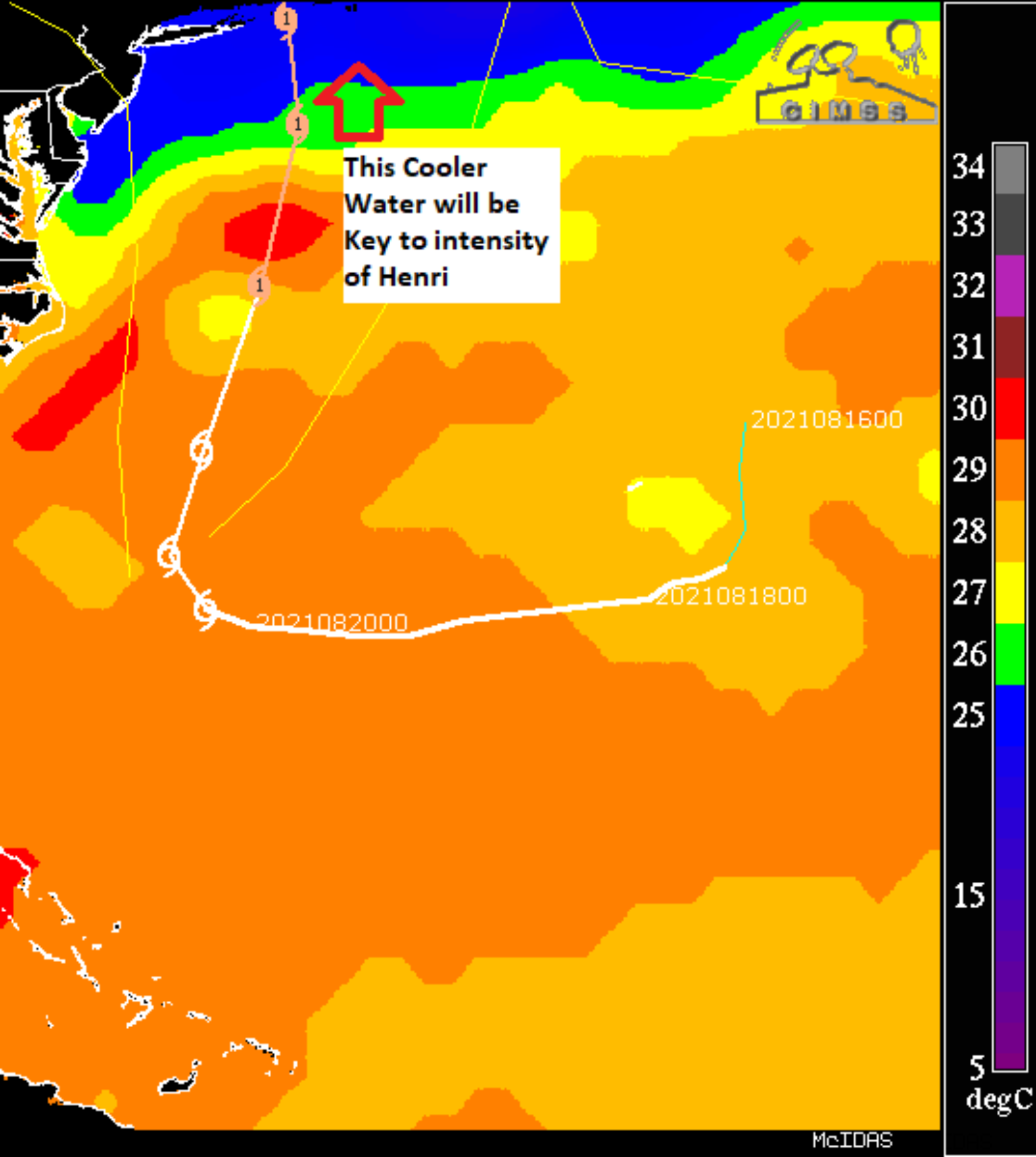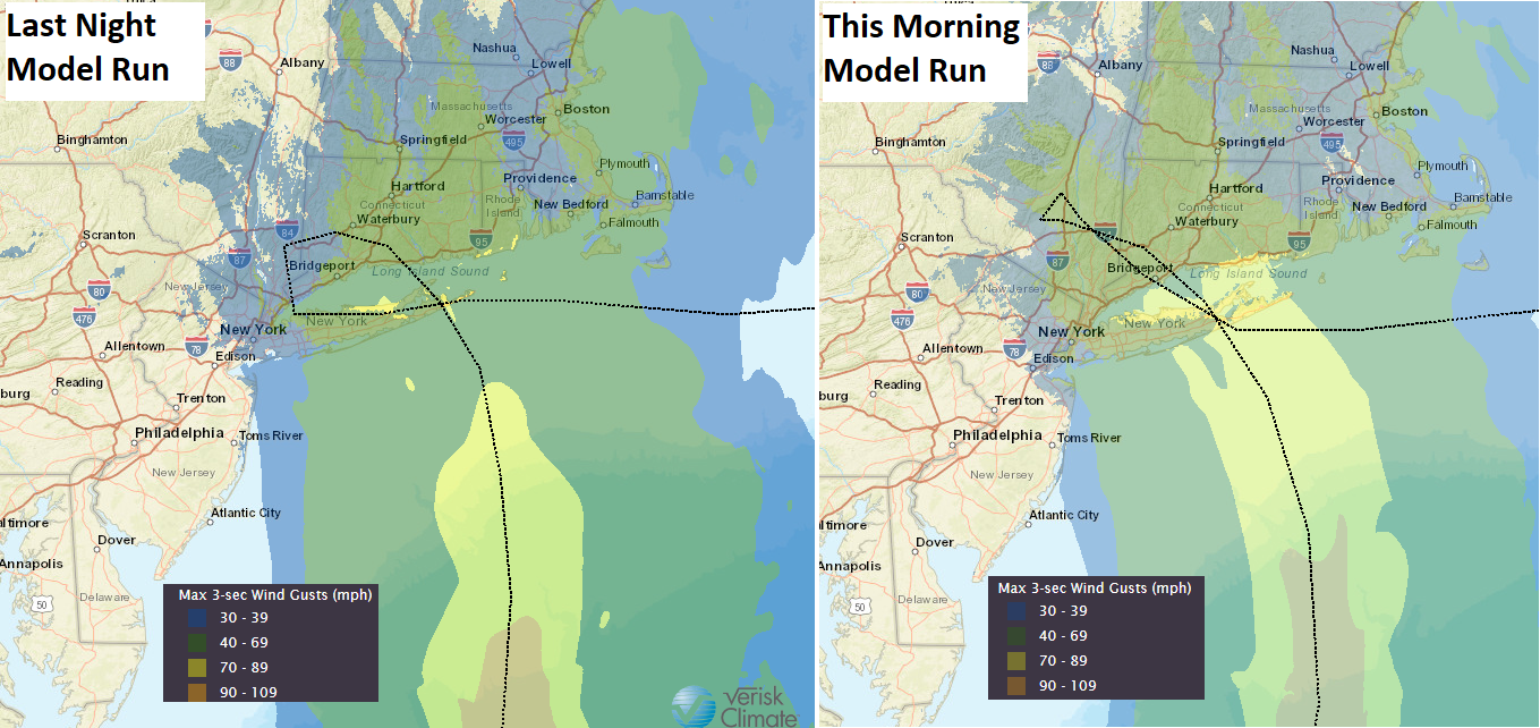The talk of the insurance industry right now should be focused on Tropical Storm Henri, which so far is considered a bonus storm of the 2021 Atlantic Hurricane season considering it formed outside of the topics at 30 degrees North. It is part of the broader uptick in convection over the Atlantic Basin that was talked about in the last BMS tropical update. Due to weak steering currents, Henri has drifted westward south of Bermuda and will hitch a ride north along a large-scale mid-latitude trough of low pressure that is moving into the Great Lakes region today. The forecast for Henri over the last week has been remarkably complex, which is why one might be taken by surprise by a hurricane or tropical storm impacting New England this weekend. The forecast remains complex which will add to some of the uncertainty around potential insured loss impacts from Henri.
New England Hurricane History
Strangely, yesterday was the 30th anniversary of Hurricane Bob impacting New England. In fact, many might find it hard to believe that no other hurricane has impacted an area within 60 miles of Block Island, RI since Category 2 Hurricane Bob did 30 years ago. This is one of the most interesting hurricane statistics that never gets talked about. The return period for an event passing within 50 miles of the Eastern tip of Long Island is 17 – 20 years, with a little bit lower return period around Cape Cod because it sticks out in the Atlantic a bit more. However, the fact that a hurricane has not impacted New England in 30 years is almost unprecedented. Furthermore, the longest stretch between storms in New England was between 1896 and 1938 at 42 years. The last time the National Weather Service has issued a hurricane watch for New England was 3,644 days ago for Hurricane Irene that occurred in August 2011. Lastly, weather historians might remember the name, Henri. Back in 1985 Tropical Storm Henri packed 60 mph tropical-storm-force winds as it made landfall in Eastern Long Island near the Rhode Island Connecticut border three days before Category 1 Hurricane Gloria also impacted the same area. Bottom line: hurricane impacts into New England are rare. This will ultimately cause major issues for the insurance industry when they do occur.
Many in the insurance industry also might remember back to just last year when Isaias raced up along the East Coast of the U.S. after making landfall near the South Carolina and North Carolina border as it merged with a mid-latitude trough resulting in greater impacts in New England as a tropical storm than as a hurricane in the Carolinas. The majority of the $2 billion in insured loss resulted from impacts due to tree damage in New York and Connecticut. This is also likely to be one of the main impacts from Henri.
Likely Impacts
It is too early to provide insurance loss estimates from Henri, but we can start to talk about some of the major impacts that are currently a concern for the insurance industry. The general forecast for Henri is for it to move almost due north from its current location. Although Henri is currently a smaller tropical storm due to stronger wind shear, this is expected to weaken later today and will allow Henri to take advantage of warmer waters of the Gulf Stream over the next 48 hours. Henri is expected to become a hurricane sometime on Saturday. At this time Henri will also grow in size, which will broaden the overall wind field. This will also make it harder for it to become anything more than a weak to medium Category 1 hurricane. After 48 hours Henri is expected to slow and move over cooler waters south of New England which should result in quick weakening. Remember the rule of thumb is the water temperature needs to be 26 degrees C (78 F) to support tropical convection. The water temperatures off New England are currently 23 C (73F). The real question is how fast will this slower motion and cooler water weaken Henri as it approaches New England. The weakening could be pretty quick, or it could be slow which is currently a large unknown at this point. One has to wonder if we will see the rapid weakening that happened to Hurricane Irene in 2011.

Wind Impacts
The overall wind impacts are tricky because a lot will depend on how strong Henri becomes in the next 24 hours as it tracks over water temperatures of 29 – 30 degrees C and how fast it weakens once it loses that warmer water just south of New England. Henri could be one of the slowest moving tropical storms or hurricanes to ever impact the area. Regardless Isaias showed how vulnerable trees are in the area. Due to the lack of large-scale, high wind events, with leaves on many of the trees in the area are due for a good natural cleaning. This cleaning of old or rotten, weak trees and limbs can only occur with large-scale wind events with leaves on when the highest wind stress can occur. The fact that Henri will be slowing down or even stalling and resulting in a prolonged wind event could make matters worse. Even winds of 30 – 40 mph over 24 hours can increase tree stress leading to failure, which could result in higher insured loss. It should be expected that any property with high tree cover is at risk of seeing some type of damage, but often this type of damage is minor and below the policy deductible.
The other thing Isaias showed the insurance industry last year was that New England does not have a good track record on power restoration. In even a weak hurricane or tropical storm, there will be plenty of prolonged power outages for the region which can have implications on commercial insured losses due to business interruption.

Rainfall / Flooding and Coastal flooding
Time and time again we have seen a scenario like this play out. Examples include: Harvey 2017, Florance 2018, more recently with a weak tropical storm, or a hurricane making landfall and stalling out and causing massive amounts of flooding. Complicating the issue with Henri is that southern New England has been wet and the soil is already saturated. Just recently the remnants of Tropical Storm Fred have provided a wet ground. Boston, MA, and Worchester, MA each had their wettest July on record, and Hartford, CT came in second place. Near a foot of rain has fallen in Worchester, MA since July 1. The ground is saturated and this wet ground will further elevate tree fall risk from this potential prolong wind event.

Coastal flooding could be a big issue depending on the overall size of Henri. The larger and slower the circulation the easier it is for water to build upon itself as the winds will allow for the water to spread along the coastline and pile up in the many inland bays along the south-facing New England coastline. This will all be complicated by the full moon which will be starting on Sunday and will enhance the potential for flooding.
Category 2 Hurricane Bob in 1991 produced a 10 – 15 feet storm surge into Buzzard Bay. This is not forecasted, but the areas can easily see water pile up in the bays of 3- 6 feet above normal high tide. The natural difference between high and low tide in the area can be up to 4 – 5 feet. It will be critical that the highest storm surge does not coincide with the high tide, which is expected around 8 pm on Sunday. So the timing could be a big deal and it is still too early to determine how the surge will coincide with high and low tide cycles.
Yesterday was the anniversary of Hurricane Bob and today is officially the start of the peak of the Atlantic hurricane season. The climatologically most active portion of the Atlantic hurricane season. Historically, 70% of all Atlantic major (Category 3+) hurricane activity occurs between August 20 - October 10. The insurance industry has already had over half a billion in loss not counting the recent losses from Tropical Storm Fred. Henri looks to add to this loss and near average activity is expected in the Atlantic basin over the next two weeks with potential new development in the Caribbean or Gulf of Mexico next week. However, in the meantime, all eyes should be on Henri and how strong it gets in the next 24 hours and how fast it will weaken late Sunday night. Remember there is little difference between a 70 mph tropical storm and a 75 mph hurricane and this wind speed difference often means very little in terms of impact to the insurance industry.
